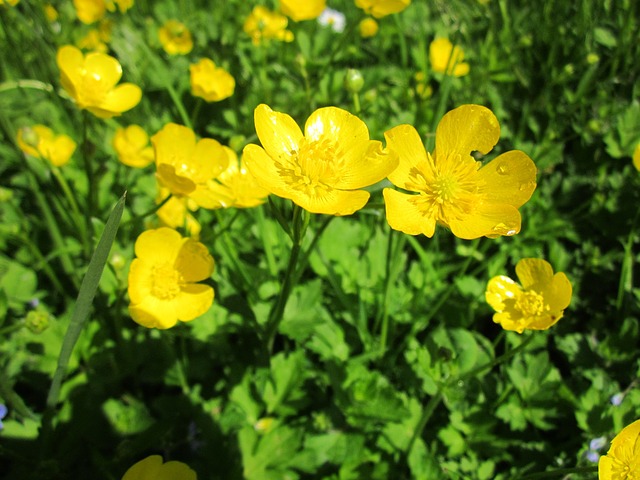
Images courtesy of Pixabay
Buttercups by Eliza Cook
From ‘The Poetry of Flowers’ by Mrs Kirtland 1800
‘Tis sweet to love in childhood, when the souls that we bequeath
When we feed the gentle robin, and caress the leaping hound,
And linger latest on the spot where buttercups are found:
When we seek the bee and ladybird with laughter, shout, and song,
And think the day for wooing them can never be too long.
Oh ! ’tis sweet to love in childhood, and though stirred by meanest things.
The music that the heart yields then will never leave its stings.
~*~
‘Tis sweet to love in after years the dear one by our side;
To dote with all the mingled joys of passion, hope, and pride;
To think the chain around our breast will hold still warm and fast,
And grieve to know that death must come to break the link at last.
But when the rainbow span of bliss is waning, hue by hue;
When eyes forget their kindly beams, and lips become less true;
When stricken hearts are pining on through many a lonely hour,
Who would not sigh “’tis safer far to love the bird and flower?”
~*~
‘Tis sweet to love in ripened age the trumpet blast of Fame,
To pant to live on Glory’s scroll, though blood may trace the name;
‘Tis sweet to love the heap of gold, and hug it to our breast,—
To trust it as the guiding star and anchor of our rest.
But such devotion will not serve—however strong the zeal —
To overtlirow the altar where our childhood loved to kneel.
Some bitter moment shall o’ercast the sun of wealth and power.
And then proud man would fain go back to worship bird and flower.
~*~
‘Do you like butter?’
Everyone knows of the buttercup game children, and often lovers play to find out if their friend or partners like butter. The bright yellow petals will shine upon the skin when the pretty flower is held beneath the chin. This little folk legend has been passed down through many generations, the research I have done on flowers has not helped me find the origin.
However, I did find some scientific facts that Cambridge physicists in the UK have discovered that the buttercup is able to shine upon the skin and other surfaces because the cells of the petals contain carotenoids which reflect yellow light. Unlike many other wildflowers the reflection of the yellow light is enhanced because the buttercup has a second layer of cells separated by a layer of air which makes it shine all the more brighter. I still love the game and it often brings happy memories.
~*~
***WARNING***
One thing I did not know was that the buttercup actually contains toxins, the poisonous substance is called ranunculin. It is found in the flower, the leaves and the seeds especially if crushed.
Sensitive folk may have a reaction to the pretty flower causing their skin to become blistered and irritated. Animals as well as humans will experience a variety of other symptoms, such as excessive salivation, nausea, difficulty breathing, convulsions and sometimes paralysis if the buttercup is eaten. So you have been warned.
~*~
I hope you enjoy this feature on my blog I would love to read your thoughts. Poems similar to this are featured in my book ‘Lost Love in Spring’
Happy Reading


Reblogged this on johncoyote and commented:
Please read and enjoy the work of a outstanding writer.
LikeLiked by 1 person
I liked this poem. Hopeful and beautiful words.
LikeLiked by 1 person
Thanks for dropping by John I love the floral poetry the words draw you in so much you can almost smell the perfume of the petals
LikeLiked by 1 person
You are welcome. I enjoyed your work.
LikeLike